- Author Matthew Elmers [email protected].
- Public 2023-12-16 21:49.
- Last modified 2025-01-24 09:17.
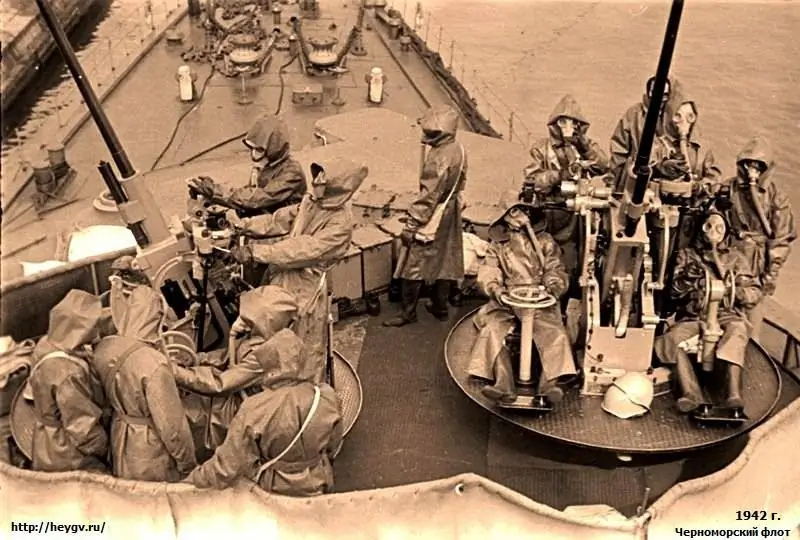
November 13, 1918 - The day of the creation of the troops of the RKhBZ of Russia, it was then that the Chemical Service of the Red Army was created. This was a necessary and forced measure of the Soviet government to prevent the threat of unleashing chemical warfare against the Red Army by the White Guards and interventionists - there have already been cases of the White Guard using OV against units of the Red Army. In contrast to the useless and ineffective shelling of Tambov forests and swamps with chemical projectiles at the initiative of Tukhachev during the suppression of the Antonov uprising, it is not customary to talk about this now. Meanwhile, about 60 episodes of the use of chemical munitions by the interventionists and White Guards on the Northern Front are known. As a rule, British-made shells were used and in a fairly large number. For example, on August 10, in the Sludka-Lipovets area and near the village of Gorodok, according to British data, 600 mustard gas and 240 tear gas shells were fired. At the same time, about 300 Red Army soldiers were poisoned, and many were temporarily blinded. Such a number of casualties could have been avoided if the soldiers knew how to properly use protective equipment.
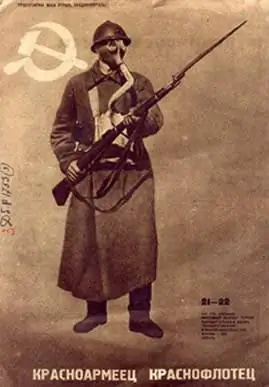
After the civil war, the chemical service was continuously developed and improved. Assessing her general condition, K. E. Voroshilov noted in 1940 that "We can say that we will not be unarmed in front of chemical weapons, and we will be able to protect Soviet troops from an enemy chemical attack." Soon after the start of the war, a number of facts became known about Germany's preparation for the use of chemical weapons against the Red Army and the population of the Soviet Union. Already on July 15, during the battles west of Sitnya, our troops seized secret documents, as well as the chemical property of the German 2nd Battalion of the 52nd Chemical Mortar Regiment. One of the packages bore the inscriptions: "Mobilization case", "In no case should you give it into the hands of the enemy", "Open only after receiving the signal" indanthren "from the headquarters of the main command." Among the captured documents were also the secret instruction ND No. 199 "Shooting with chemical projectiles and mines", published in 1940, and additions to it, which were sent to the fascist troops on June 11, 1941, on the eve of the outbreak of war against the USSR. They contained meticulously developed instructions on the technique and tactics of using the OF. In addition, in addition to the instructions, it was said that the chemical troops should receive new mortars of the 40 caliber 10 cm model and the D sample, as well as chemical mines with various potent toxic substances. It was also emphasized here that toxic substances are a means of the High Command of the Wehrmacht and should be used on his orders suddenly and massively.
Subsequently, it turned out that on March 25, 1941, the chief of the General Staff of the German ground forces, Halder, reported that by June 1 the German army would have 2 million chemical rounds for light field howitzers and half a million rounds for heavy ones. There are already sufficient charges for chemical warfare. You only need to fill the shells with them, which has already been ordered. From the warehouses of chemical ammunition, the Germans were ready to ship 6 echelons of chemical ammunition by June 1, and from June 1 to 10 trains daily. As you can see, the preparation of the Nazis for the use of OV was serious.
With such information, the People's Commissar of Defense I. V. Stalin, in his order in August 1941, in order to protect Soviet troops from warfare, demanded "to make the chemical protection service part of the combat use of troops and in the most decisive way to suppress the underestimation of the chemical hazard …". And the fact that such a danger was underestimated is evidenced by the fact that well-trained divisions of chemical protection of divisions and regiments, as well as officers of the chemical service began to be used for other purposes. Chemists from regimental platoons and divisional companies of chemical protection were taken to replenish rifle units, used for commandant service. More than once, vehicles adapted for degassing work were confiscated from the chemical divisions. The chiefs of the chemical service, mainly in the regiment-corps link, often replaced the outgoing commanders of subunits and units, and served as staff officers.
The same order required: “Eliminate the careless attitude towards the preservation of chemical property. The property that has become unusable should be written off according to acts signed by the proper commander and commissar of the division, as well as approved by the head of the Front's Chemical Directorate. This significantly increased the responsibility of the commanders of formations, units and chiefs of the chemical service for saving chemical protection equipment.
There were also some changes in the organization of the chemical service and chemical protection troops in the fall of 1941. The Directorate of Military Chemical Protection was transformed into the Main Military Chemical Directorate (GVHU), and the chemical departments of some fronts were transformed into military chemical directorates. Taking into account the fact that the main task of the chemical protection units of regiments and divisions was the organization of PCZ troops, they received the appropriate names: the anti-chemical defense platoon of the rifle regiment began to be called the chemical protection platoon, the degassing company of the rifle division - a separate chemical protection company. The degassing battalions of the RGK were reorganized into separate chemical defense battalions (obhz).
The chemical departments of the armies were also strengthened. An additional chemical weapons engineer and an assistant to the head of the operational and reconnaissance department were added to their staff. Political organs and the media launched a great educational work among the personnel, during which they instilled even greater hatred of the fascists who were preparing a chemical war, explained in the press and practically showed the reliability of our anti-chemical protection means, issued special memos to the warrior. In the active forces on the defensive, as well as in units of the second echelons and the reserve, classes were organized to study the techniques and rules for using personal protective equipment and degassing weapons. Activities were also carried out to improve the qualifications of chemical service officers (training camps, special classes).
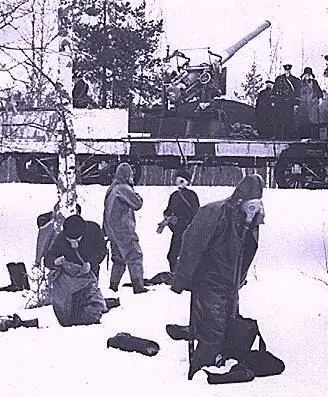
The GVHU in May 1942 issued the "Temporary instruction on chemical exploration". It outlined not only the issues of conducting chemical reconnaissance, but also indicated measures to alert the troops about a sudden chemical attack by the enemy and the timely use of protective equipment. This important document was used by all chemical service officers from the summer of 1942 until the end of the war. During battles, and primarily in defense, Soviet units and subunits carried out continuous chemical observation. It was carried out not only by observer chemists, but also by combined arms and artillery observers. For example, during the defense of Stalingrad, combined arms chemical reconnaissance, reinforced by groups of chemists, was carried out to a depth of 15 km. Reliable surveillance and warning was organized. In particular, in the 21st Army of the Stalingrad Front, up to 50 forward and 14 rear chemical observation posts were set up, provided with means of indication and signaling.
The plans and schemes for organizing communications indicated special signals and the procedure for alerting our troops in the event of the use of chemical weapons by the Germans. Of great importance for the further development of the anti-chemical protection of troops was the order of the NKO in mid-August 1942, which put into effect the "Temporary Instruction on the provision of anti-chemical protection of troops by the services of the Red Army." The instruction determined the duties and specific tasks of not only chemical, but also sanitary and veterinary services for the provision of PCP troops.
The chemical service was entrusted with training troops in the rules for using individual and collective means of PCP, degassing and indicating OM; warning troops about the preparation and start of a chemical attack on the enemy; conducting reconnaissance of terrain and weather; discovery of local funds suitable for PCP. When eliminating the consequences of a chemical attack by the enemy, the chemical service was supposed to degass weapons, military equipment, contaminated areas, uniforms and equipment. The sanitary and veterinary services of the Red Army were to supply and train troops in the use of individual anti-chemical bags (IPP) and special bags for horses and service dogs; chemical exploration of water, food and fodder sources, organization of their neutralization and preparation for subsequent use; full sanitary treatment of people and veterinary treatment of animals infected with persistent agents.
Thus, the first period of the war was characterized by a significant increase in attention to the issues of chemical protection and the implementation of major organizational changes in the chemical service of the Red Army. Methods for organizing PCP were carried out according to the specific conditions of the situation.
Educational and explanatory work, aimed at improving chemical discipline in the troops, at eliminating carelessness and underestimation of chemical danger, acquired particular importance. The activities of the chemical service, units and units of protection in the second period of the Patriotic War took place in an environment that was different from the conditions of the first period. This is primarily due to the fact that the successive defeats of enemy troops on the Soviet-German front after their encirclement at Stalingrad led to an even greater increase in the danger of unleashing a chemical war by the Nazis. Moreover, this danger became especially real after the defeat of the German troops near Kursk. Intelligence data of all types indicated a sharp intensification of the activities of the fascist command to carry out PCP measures and prepare for the use of chemical weapons. The enemy troops began to receive new gas masks and chemical reconnaissance devices.
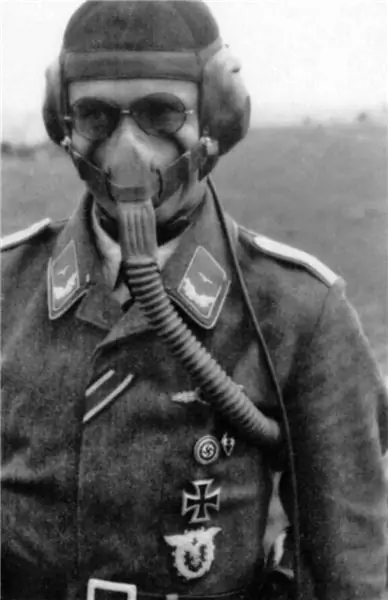
It should be noted that the offensive became the main type of combat operations of our troops during this period of the war. Therefore, all PCZ measures were to be aimed at providing an offensive battle. Although the anti-chemical protection of troops by the end of 1942 had become more perfect in comparison with 1941 and the first half of 1942, it also had a number of shortcomings. The checks carried out revealed the facts that some commanders continued to underestimate the danger of the use of chemical weapons by the Germans. They removed themselves from the leadership of the anti-chemical defense, shifting it to the chiefs of the chemical service. Training of troops in anti-chemical protection and training for a long stay in gas masks during combat work were carried out irregularly. There have been losses of chemical property, especially in offensive battles. On the whole, given the intensity of hostilities during that period, these violations were quite natural. On January 11, 1943, the People's Commissar for Defense issued order No. 023, which stated: "For every fact of damage, loss and failure to take measures to preserve chemical property, punish the guilty, up to the point of being brought to trial by a military tribunal."
This decisive demand greatly reduced the loss of gas masks and helped to increase the readiness of troops for chemical protection. In 1943, the Field Manual of the Red Army (PU-43) was published, in which the issues of anti-chemical protection of troops were quite clearly stated in the event that the enemy began to use chemical weapons. Chemical exploration has become more active. Its main tasks boiled down to the following: detecting parts of the enemy's chemical attack in front of the front of our troops, seizing samples of chemical ammunition, new anti-chemical defense equipment and operational documents on a chemical attack. The most important methods of chemical reconnaissance were: chemical observation by forces and means of chemical units, supplemented by combined arms and artillery observers; the inclusion of reconnaissance chemists in combined arms reconnaissance groups and detachments when conducting reconnaissance in force; interrogation of prisoners, especially chemists, gunners and pilots; survey of local residents.
Chemical intelligence has become more successful in coping with the assigned tasks. Sometimes she obtained data on the enemy's chemical weapons even before it entered his troops. An example is the capture of the German manual "ND-935-11a 1943" with a description of a new chemical reconnaissance device.
In the summer of 1943, on the eve of the Battle of the Kursk Bulge, the Supreme High Command, in its directive of June 7, 1943, signed by I. V. Stalin and A. M. Vasilevsky, warned the troops about the real threat of the use of chemical weapons by the Nazis. In it, in particular, it was said that the Headquarters had information about the recent strengthening of the German command in the preparation of its troops for the use of chemical attack weapons. It was also noted that in the German command "there are enough adventurers" who, hoping to catch us by surprise, can decide on a desperate adventure and use means of chemical attack against us.
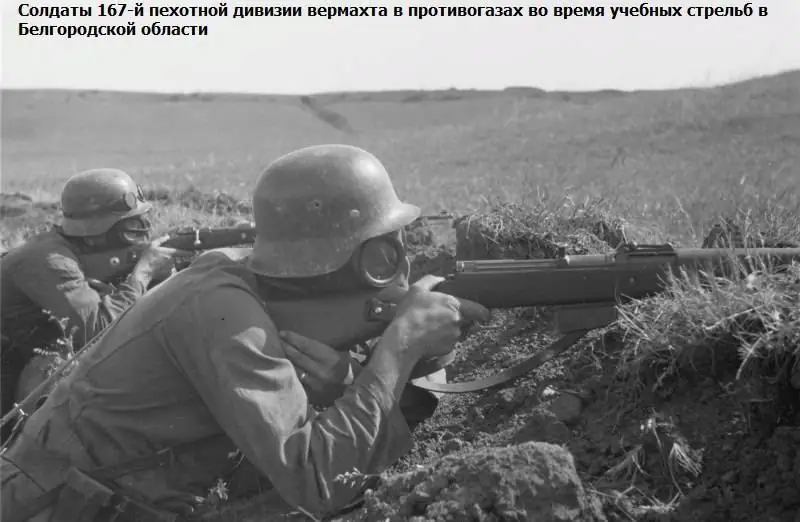
The current situation obliged the chemical service and the chemical protection troops of the Red Army to direct all efforts to exclude the sudden use of chemical weapons by the fascist command, and to properly prepare their troops for chemical protection. The troops began work on training personnel in chemical protection. At the same time, the main attention was paid to the practical use of personal protective equipment, to instilling skills in degassing weapons and mate parts. Classes were usually held in the rear areas and ended with fumigation with chloropicrin in gas chambers (tents).
The officer corps of combined arms units studied the means of chemical attack of the enemy and learned how to control units (subunits) in conditions of widespread use of chemical weapons by the enemy. These classes were conducted by the most trained chiefs of the chemical service. In turn, officers of the chemical service and chemical protection units were trained according to a 200-300-hour program approved by the Main Military Chemical Directorate.
On the basis of the instructions of the Headquarters of the Supreme Command in 1943, the practice of using gas masks continued when performing combat operations. In each unit (institution), gas mask training was conducted daily according to plans developed by the chief of the chemical service and approved by the unit commander or chief of staff. Particular attention was paid to the training of new recruits. So, during the Battle of Kursk in the troops of the Steppe Front (7th Guards, 53rd and 57th armies), the duration of continuous stay in gas masks by September 1, 1943 was brought to 8 hours.
The directive of the Supreme Command Headquarters of June 7, 1943 also established a new procedure for providing troops with gas masks. To reduce the loss of personal protective equipment, gas masks were handed out only in defense, and exclusively to the personnel of the first echelon units. Before the offensive, they surrendered to battalion supply points and were transported behind the advancing troops. To transport gas masks, each rifle battalion allocated three horse-drawn carts at the disposal of the ammunition supply point. The reception of gas masks from the subunits, their delivery to the battalion point and their subsequent handover during the transition to the defense were carried out by the chemical instructors of the battalions (artillery divisions, cavalry squadrons). However, practice has shown that this method of transporting gas masks had a significant drawback. The fact is that the animal-drawn transport allocated for this was often used to deliver ammunition. This led to the backlog of personal protective equipment from the troops. In October 1943, on the initiative of the chiefs of the chemical service, regimental "consolidated detachments" were created under the chemical protection divisions to transport chemical property. Thanks to this, the loss of gas masks has been significantly reduced. For example, on the Western and Southwestern Fronts, the loss of gas masks has decreased (in a rifle division) from 20 pieces per day to 20 pieces per month. At the same time, the immediate issuance of gas masks to personnel was guaranteed upon receipt of the first data on the threat of a chemical attack by the enemy.
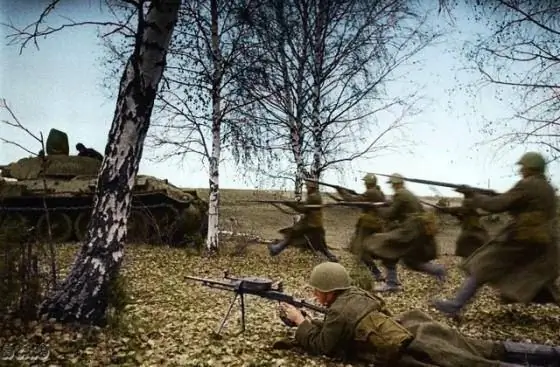
It is worth noting that from the beginning of 1943, on the basis of the instructions of the GVHU, simplified degassing means began to arrive in the troops. This was due to the fact that the industry could not fully satisfy the needs for office property. Prefabricated funds were directed mainly to the armament of individual chemical defense battalions.
For the degassing of uniforms and equipment in the companies of chemical protection of rifle divisions, a transported degassing kit (DK-OS) was introduced, which consisted of two collapsible chambers for degassing with hot air, one collapsible chamber with a steam source and two barrels for degassing using a steam-ammonia method without a special source of steam. In order to degass the contaminated area with a free-flowing degasser in the divisions' chemical protection companies, a suspended area degassing device (PDM-2) was introduced, the bunker of which was attached instead of the rear side of the truck, and the seeding mechanism was driven by the drive from the rear wheel of the car.
For the degassing of weapons in rifle units, a group degassing kit (GDK) was adopted, consisting of a plywood box, 6 bottles with a capacity of 0.5 liters each with a liquid degasser and 3-5 kg of tow (rags). Thus, in rifle companies, a single-stage degassing of weapons and equipment was introduced instead of a two-stage (preliminary in battle formations and complete at special degassing sites). This event was very effective, as it simplified and accelerated the process of degassing weapons in the troops.
Considering that in the fascist army about three-quarters of all available poisonous substances were mustard gas, in 1943 the troops began to carry out the so-called desipritis for training purposes (special treatment of the skin of soldiers infected with droplet mustard gas), necessary to familiarize all personnel with combat mustard gas (appearance, smell, toxic properties); practically work out the methods of degassing against this OM on human skin and uniforms with various degassers, solvents and improvised materials; instill in the soldiers the confidence that individual anti-chemical bags (PPI), as well as other degassers (solvents) are reliable means of treating a mustard-infected skin area. Discipline was carried out under the guidance of officers of the chemical and sanitary services. The results were quite satisfactory. So, in the 4th Shock Army of the Kalinin Front, out of 40,000 fighters and officers who underwent desiprisation in the winter and spring of 1943, only 35 people had slight reddening of the skin. The practical significance of this event can hardly be overestimated. After it was carried out in many formations and positive results were obtained, the GVHU of the Red Army was obliged to carry out disinfection in all troops.
In the troops on the defensive, in the first half of 1943, significant work was carried out to equip positions in anti-chemical terms. At command and observation posts, in operating hospitals and medical centers, shelters were created with the installation of factory-made filter-ventilation kits in them. Above the trenches and trenches, canopies and sheds were made to protect against watering with liquid droplets. In addition, shelters were built in rifle companies (artillery batteries), in which filter fans were installed from improvised means. A typical example in this respect is the already mentioned 4th Shock Army of the Kalinin Front. By order of the commander of the formation, Lieutenant General V. V. Kurasov, in the gathering area of the entire command staff of the armies at the beginning of the winter of 1942/43, engineering and chemical units created standard shelters for companies, command posts, NP and medical posts. After the gathering, by order of the commander, the equipment of similar shelters began at all positions, command, observation and medical posts of the army.
In the second period of the war, great attention was also paid to the organization of PCPs in the rear units and institutions of the fronts and armies. The posts of chiefs of the chemical service of the rear of the front and the army were introduced. In the line of duty, they were guided by the "Regulations on the work of the head of the chemical service of the front (army) rear services" dated April 2, 1943 and "Temporary instructions for organizing the PCZ rear facilities", signed at the end of 1943 by the head of the Central High School and the Deputy Head of the Red Army Logistics. Thus, the activity of the chemical service in the second period of the Patriotic War consisted, first of all, in ensuring a higher readiness of troops and rear services for anti-chemical protection in the conditions of the transition of Soviet troops to a strategic offensive.
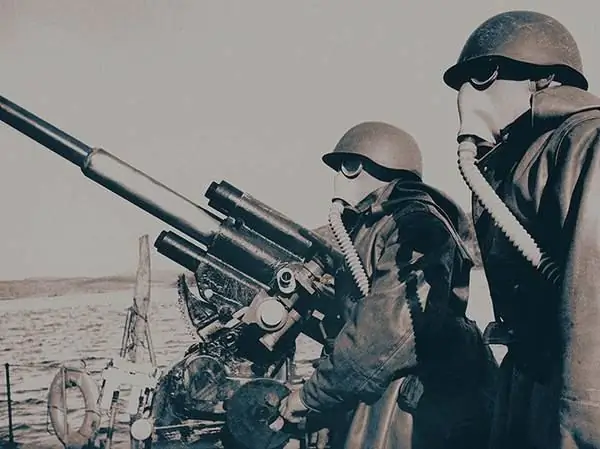
The third period of the Patriotic War is characterized not only by our swift offensive actions, as a result of which the enemy was expelled from Soviet soil, but also by the fact that hostilities were transferred to the territory of Germany and its allies. Therefore, the obvious inevitability of the complete defeat of the fascist army further increased the danger of unleashing a chemical war. Any adventure could be expected from a mortally wounded fascist beast. To postpone the hour of their death, the Germans were ready to use any means.
All this posed the task of ensuring the constant readiness of Soviet troops to repel a chemical attack before the chemical service. Distinctive features of the organization of the chemical service in the third period of the war were the centralization of planning and management of all PCP activities carried out in the troops. As before, primary importance was attached to chemical reconnaissance, which faced new tasks in connection with the withdrawal of Soviet troops to areas that had been occupied by the Nazis for a long time. Its task was not only to identify the degree of preparation of the enemy for the use of chemical weapons, but also to establish the level of development and direction of production activities of its chemical and military-chemical industries, the state of the scientific and technical base. She also had to clarify the correctness of the data on the preparation of the Nazis for the use of OV, which were obtained earlier.
The reconnaissance of the liberated or occupied territory was carried out by special reconnaissance groups created from subunits and units of chemical protection (orkhz, obkhz), by examining the area and important objects. Chemical reconnaissance was planned for a battle, an operation, and during operational pauses - for a period set by the command. The chemical departments of the fronts usually planned chemical reconnaissance for a month, and the chemical departments of the armies - for 10-15 days.
In the formations and units, a separate chemical reconnaissance plan was not developed, and its tasks were included in the general plan of the PCP. Much attention was paid to the anti-chemical training of troops, which was carried out during the period of operational pauses. A characteristic feature of this was that it was no longer limited only to individual training of personnel, but also pursued the goal of checking the implementation of measures according to the PCZ plan of the unit (formation). Usually, such a check was carried out in the form of a sudden announcement of training chemical alarms, which took place according to the plans of the headquarters of the armies and fronts, and were unexpected not only for the personnel of the units, but also for the chiefs of the chemical service. Sometimes, by the decision of the relevant military councils, such checks were carried out on the scale of armies and even fronts. So, for example, on October 16, 1944, a chemical alert was announced to the troops of the 1st Ukrainian Front. The fact that it was of a training nature was known only to the command, the front headquarters and the persons assigned to check the actions of the troops. Therefore, all measures in the troops were carried out without admitting any conventions. The inspection showed that 4-5 hours after receiving a warning about the "chemical hazard", the front's troops were already basically ready to defend against a possible chemical attack. Subsequently, the efforts of the command and the chemical service of the front were aimed at reducing these terms.
During the final offensive operations carried out by other fronts, personal protective equipment was constantly in the hands of troop personnel. The peculiarities of the organization of PCPs during the third period of the war led to the appearance of a number of changes in the system of supplying troops with chemical equipment. They were aimed at re-targeting the entire supply system in the face of wide and rapid offensive operations of our troops. The experience of organizing the supply of troops with chemical equipment revealed the need to transfer these functions from the military-technical supply service directly to the chemical service. This led to the restoration in March 1944 of the post of assistant chief of the chemical service of the supply division, in whose subordination were the "consolidated detachments" created back in 1943 for storing and transporting protective equipment. In addition, in the same 1944, the chemical warehouses of the armies were withdrawn into an independent organization. As you can see, the chemical service of the Red Army in the third period of the war became an integral part of the combat support of the troops. At the same time, the organization of the PCZ troops approached the conditions for waging a war with the use of chemical weapons.
The rich experience accumulated by the chemical service in organizing PCP troops in World War II was fully used during the war against Japan, whose military leadership for many years also intensively prepared for the use of chemical and bacteriological weapons against our army and country. The Japanese had experience of using it in the war with China. Therefore, the Soviet command attached great importance to ensuring the constant readiness of troops for anti-chemical protection and excluded the possibility of a sudden chemical attack. In the organization of PCZ troops in the war against Japan, in comparison with the Soviet-German front, there was no fundamental difference, but there were some peculiarities.
First, the number of chemical defense battalions in the fronts has significantly decreased. Instead of 6-8, in operations on the Soviet-German front in the Far East, there were 1-2 battalions in the fronts. This led to an increase in the number of PCZ platoons and chemical protection companies at the expense of combined arms subunits approximately twofold.
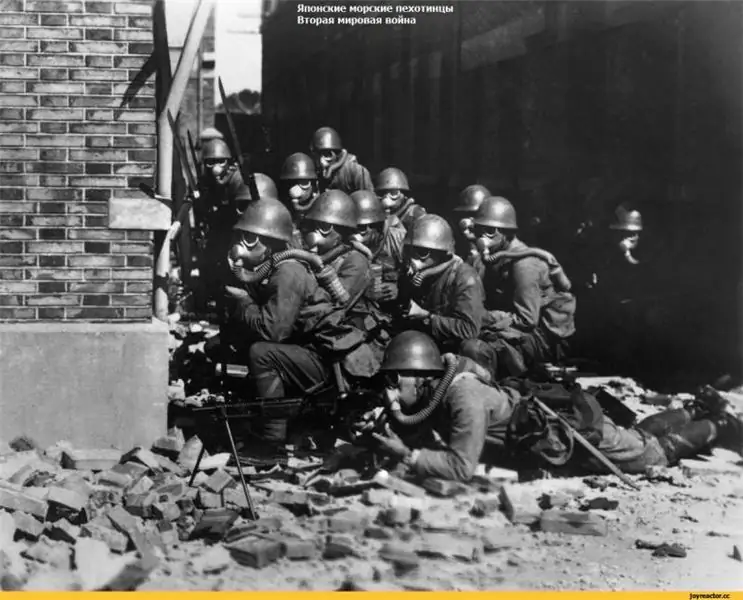
The second feature was that, due to the significant distance from each other of the offensive zones (especially on the Trans-Baikal and 2nd Far Eastern fronts) of the armies, the direct management of their chemical departments was carried out by permanent representatives of the chemical directorates of the fronts. In general, the chemical service was constantly being improved during the Second World War. She has done significant work aimed at preventing the death of millions of people in the event of a chemical war by the Germans or the Japanese. It is now reliably known that one of the significant factors that prevented the Nazis from unleashing a chemical war was the high readiness of our troops for anti-chemical protection, which left the German command no hope of a surprise attack and the massive use of toxic substances with the desired effect. The experience of chemical service during the war was peculiar, for the anti-chemical protection, fortunately, did not receive a combat check. However, it was a service that actually functions, organizes and conducts the necessary events. Its main tasks were to warn its troops about chemical hazards and protect them from chemical agents.
Practice has shown that of all types of chemical reconnaissance, the most important was the direct chemical reconnaissance of the opposing enemy. Reconnaissance of the same terrain and weather was carried out on a limited scale. To obtain the most complete and objective information about the enemy in chemical terms, the data of chemical reconnaissance must be closely linked with the data of tactical, operational and strategic intelligence.
The most effective methods of chemical reconnaissance were: special chemical surveillance, reconnaissance in force and the study of documents seized from the enemy, weapons and means of protection.
The Patriotic War revealed the need to improve the means of conducting chemical reconnaissance and the system for alerting troops about chemical hazards.






